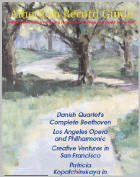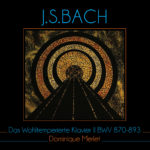Reviewer: Bradley
Lehman
As he did with Book 1 (M/A
2019), Booth produces a stimulating performance on a harpsichord he designed
and built. Along with his booklet essay, his work is a master class
presenting new ideas about rhythmic profiles, tempo, and ornamentation. The
intonation isn’t completely convincing: I detailed all my practical and
historical disagreements about Booth’s “Kirnberger 3” temperament in that
review last year.
Book 2 here has the same virtues. He demonstrates a remarkably effective
formula for playing Bach on the harpsichord: pick a patient and steady
tempo, install a very subtle rhythmic inequality into your brain, and then
let the piece play itself out easily with intuitive musicianship. The
inequality is so tiny that it can’t be notated, but when other players don’t
use it the absence is felt (like making oatmeal but forgetting the dash of
salt). The piece must be learned so well that there is no struggle or
further manipulation. Booth is a world-class player. I noticed one misread
accidental in the B-major fugue, something an independent producer would
have caught for correction. That’s the hazard of an ambitious one-man
project, even one this brilliantly done: sometimes tiny errors get through.
Soundboard CDs (Booth’s label) are available through Raven Recordings
(804-355-6386; 3217 Brook Rd, Richmond VA 23227), or from his own web site.
With pianist Dominique Merlet, Book 2 lacks enough interpretive direction.
The reading sounds like the variants in the Richard Jones Urtext edition
(Associated Board of the Royal Schools of Music), derived from Tovey. The
playing time is so short because he cuts the repeats in most of the
preludes. Merlet follows the pianistic practice of playing fugue subjects a
bit louder than the other voices, but they don’t recede much afterward, so
the pieces just get louder and louder as they proceed. Other than choosing
to use pedal or not, Merlet doesn’t find much variety in the music. His
articulations and dynamics don’t reveal surprising details. The delivery is
unsteady, too: his left hand comes along for the ride, trying to keep up,
instead of leading the music firmly from the bass. The left hand’s
tentativeness is especially a problem in the E minor pieces. In the D major
and D-sharp minor fugues, all the repeated notes are smeared together with
damper pedal—an effect not available on any of Bach’s keyboard instruments.
This pianistic technique of harmonic pedaling obscures the counterpoint of
other pieces as well. It reduces the musical dimensions. He changed the
project producers, sponsors, graphic designers, and annotators between
volume 2 (2016) and volume 1 (2017). He kept the same hall and Steinway
piano. The annotator’s essay for volume 2 brings out old notions about Bach
writing this music for equal temperament, but the essay for volume 1
contradicts that. Volume 2’s booklet wastes a lot of space having the same
photographic reproductions of Bach (a portrait and a statue) three times
each, and the first page of the St John Passion’s score reproduced
twice—irrelevant to this project. He brings to Book 1 a mishmash of ideas
from the Carl Czerny edition (many changed notes, an extra measure in
Prelude 1, added octaves, long legato phrasing) and Frederic Chopin’s
hand-marked copy of parts of it. Some of that Czerny edition is allegedly a
record of the way Czerny remembered Beethoven playing the pieces for him.
It’s not stated clearly which parts of Merlet’s interpretation are from
which source. Where do Chopin’s ideas overrule Czerny’s or Beethoven’s? And
why? None of these composers ever played a Steinway D, so we’re on shaky
ground historically in this venture. It seems that Merlet was grasping for
interpretive ideas, because (as heard in volume 2) he doesn’t bring enough
imagination of his own. He includes two separate takes of Fugue 19 in A, to
show that it can be interpreted in vastly different ways. One of these
efforts is supposed to emphasize a connection to the fugue in Beethoven’s
Sonata 31. This idea of radically different readings could have been taken
further, instead just this single example. Merlet’s sets are not interesting
enough to be recommendable. In both books, it sometimes sounds like a
struggle just to keep the notes together accurately—probably not what a
collector wants from a recording for years of enjoyment. If Merlet had
chosen more consistency with the Czerny reading across both books (for
better or worse), it would offer more reason for a purchase. Ashkenazy (S/O
2006), Sheppard (M/J 2008 for Book 1) and Aldwell (1989, not reviewed) are
among many who have played the WTC better on piano.
Fermer la fenêtre/Close window
|




